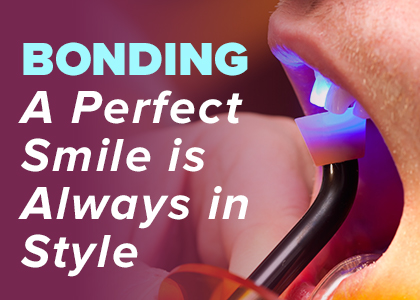Bonding: A Perfect Smile is Always in Style
Posted on May 27th, 2019
 Whether you’ve never been thrilled with your smile, or it lacks the luster it once had, dental bonding is a multipurpose cosmetic and restorative dental procedure that can be performed on patients of all ages. Bonding has the capability to fill gaps, correct damage, and refurbish the overall structure and look of your teeth. Fuquay Family Dentistry wants every patient to feel good about their smile, but if you feel less than confident in yours, we may recommend a simple and affordable treatment called dental bonding.
Whether you’ve never been thrilled with your smile, or it lacks the luster it once had, dental bonding is a multipurpose cosmetic and restorative dental procedure that can be performed on patients of all ages. Bonding has the capability to fill gaps, correct damage, and refurbish the overall structure and look of your teeth. Fuquay Family Dentistry wants every patient to feel good about their smile, but if you feel less than confident in yours, we may recommend a simple and affordable treatment called dental bonding.
What is the Bonding Procedure?
There are two different types of dental bonding: direct composite bonding and adhesive bonding. Adhesive bonding attaches a separate restoration to a tooth, so that type of bonding is used for crowns, bridges, inlays, onlays, and veneers. This article will focus on direct composite bonding, which is its own minimally invasive smile makeover procedure—and the one most people think of when they hear the terms “bonding” or “dental bonding.”
Dental bonding is a noninvasive treatment where tooth-colored material—either composite resin or a modifiable ceramic—is applied directly to the teeth. Once complete, the bonding procedure restores and rejuvenates the teeth, both in appearance and in structure. Unless bonding is being used to correct decay, the procedure rarely requires anesthesia and can be performed in a single dental appointment!
Before bonding itself can begin, the tooth surface is abraded and treated with a conditioning liquid, which facilitates the adherence of the bonding material to the tooth. Since preparation to bond teeth is not very extensive, the bulk of existing natural tooth structure can be saved—and the bonding resin can fuse itself to the natural tooth, strengthening it in the process. Bonding resin has a consistency that resembles putty and is color-matched to natural teeth before being applied, molded, and smoothed to the preferred shape.
Once bonding resin has been applied and the desired effect has been achieved, an ultraviolet (UV) light or laser is used to harden the material. Once the bond has hardened, it is trimmed, shaped, and polished to match the rest of the tooth’s natural sheen and shape. The overall bonding process averages 30 minutes per tooth.
When is Bonding a Good Solution?
Every dental situation is different, but here are some situations where bonding may be recommended:
- To repair decayed, chipped, cracked, broken, fractured, or otherwise physically damaged teeth
- To improve the appearance of teeth – close a gap, fix alignment, make tooth shape more uniform
- To fill in tooth root area that has been exposed by receding gums
- As an aesthetically pleasing alternative to metal amalgam fillings (depending on location in the mouth and extent of decay)
How Should Bonded Teeth Be Cared For?
Bonded teeth look, feel, and function like natural teeth and should be cared for with a sound oral hygiene routine. Beverages like soda, dark-colored juices, and sports drinks should be avoided whenever possible to prevent stains. If you bite your fingernails, eat ice or chew pencils and pens, you should consider quitting because these habits chip away at bonding material (and natural teeth!)—so if you recognize yourself in any of these vices, quit it!
Will Future Dental Restoration Be Needed?
While bonding composite isn’t quite as durable as natural tooth enamel, with proper care, it can usually last for an average of ten years before repair is needed. Bonding resin, just like natural enamel, does show visible wear and tear, dulling with age, and staining over time. Depending on your individual dental situation, a more permanent restorative procedure like a crown or veneers may be the best long-term decision.
Bonding Pros & Cons
Pros:
- Takes an hour or less to apply
- Less expensive alternative to fillings or other restorations
- Looks natural – bonding solution is matched to natural teeth
- Minimally invasive
- Rarely requires anesthesia
- Does not reduce natural tooth structure
Cons:
- Can stain or dull over time
- Easier to break or chip than other restorations
- Will likely require repair or restoration in the future
What to Do Following a Bonding Treatment
If you just had a bonding treatment, or are considering bonding, here’s what you should know following the procedure to ensure the best results. Avoid eating or drinking foods that stain (coffee, tea, red wine, etc.) for the first 48 hours. Call your Fuquay-Varina dentists if you notice sharp edges, if chips or pieces fall out, or if your teeth feel strange or “off” when biting down.
It’s hard to tell dental work has been done on bonded teeth—all people notice is that your smile looks fantastic. Contact us today if you have questions or would like to learn more about dental bonding. Dr. McCormick, Dr. Meunier and Dr. Adams look forward to increasing your smile confidence. Get ready for lots of compliments!
The content of this blog is not intended to be a substitute for professional medical advice, diagnosis, or treatment. Always seek the advice of qualified health providers with questions you may have regarding medical conditions.